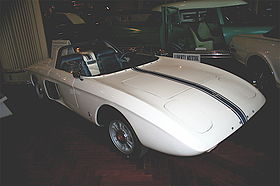Ford Mustang I
| Ford Mustang I | |
|---|---|

Ford Mustang I at the Henry Ford Museum
|
|
| Overview | |
| Manufacturer | Ford |
| Designer | Eugene Bordinat, Roy Lunn, John Najjar |
| Body and chassis | |
| Class | Concept car |
| Body style | 2-door roadster |
| Layout | mid-engine layout |
| Platform | Experimental |
| Powertrain | |
| Engine | 91 cu in (1.5 L) V4 |
| Dimensions | |
| Wheelbase | 90 in (2,286 mm) |
| Length | 154.2 in (3,917 mm) |
| Width | 62 in (1,575 mm) |
| Height | 39.2 in (996 mm) (over roll bar) |
| Curb weight | 1,544 lb (700 kg) |
The Ford Mustang I is a small, mid-engined (4-cylinder), open two-seater concept car with aluminium body work that was built by Ford in 1962. Although it shared few design elements with the final production vehicle, it did lend its name to the line.
The original Ford Mustang was a product of the Fairlane Group, a committee of Ford managers led by Lee Iacocca. The Fairlane Group worked on new product needs and, in the summer of 1962, the Group laid out the framework of a new sports car. The automaker made a "tentative bid to fill a vacuum between Go-Karts and the Corvette" as well as to compete in FIA category 9 (SCCA Class G)."Popular Mechanics compared it to the imported MG 1600 Mark II and Sunbeam Alpine Mark II sports cars.
Designer Eugene Bordinat envisioned a low-cost sports car that would combine roadability, performance, and appearance in a radical layout. Ford designer Philip T. Clark had been working on the low-slung Mustang design in varied forms for years. Bordinat coordinated the development of the styling and oversaw the first drawings into a clay model in three weeks. A 90 in (2,286.0 mm) wheelbase, 48 in (1,219 mm) front and a 49 in (1,245 mm) rear track were the working dimensions. The body skin was a one-piece unit that was riveted to a space frame. To increase rigidity, the seats were part of the body. The driver could adjust the steering column and clutch/brake/accelerator pedals.
Roy Lunn was put in charge as product planner for building the car. His racing car design experience together with his engineering really brought the concept to life. Lunn, working with Herb Misch as the project engineer, "designed the chassis to accommodate four-wheel independent suspension, rack and pinion steering, and front disc brakes." A lightweight and dimensionally small German Ford Cardinal 1,500 cc 60 degree V4 engine powered the Mustang I. The front-wheel-drive powertrain from Ford Germany's mainstream Cardinal/Taunus sedans was mounted directly behind the cockpit with the engine and 4-speed transmission in a common housing with an axle and conventional clutch.
Ford Lead Designer and Executive Stylist John Najjar favored a mid-engined configuration, cooled through two separate radiators on the sides of the car. Najjar also proposed the name "Mustang" for the concept vehicle. As an aviation enthusiast, he was familiar with the North American P-51 Mustang fighter and saw some design similarities in the diminutive but sleek profile of the new sports car.
...
Wikipedia
